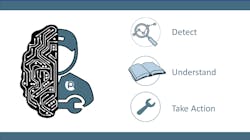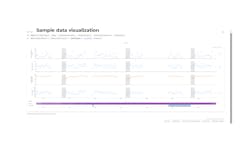How AI can help diagnose trucks
Each wave of technological innovation comes with an uneasy transition followed by adaptation. Take smartphones and clean energy, for example.
Smartphones take up a lot of free time and mental bandwidth and raise concerns about privacy and addiction for youngsters. But the world has adapted, and so has the smartphone. They have brought connectivity and access to information to people in every corner of the globe, including those in less developed countries. Smartphones are now an essential tool for everything from banking to dating.
Read more: All-makes ADAS tools help shops keep up with increased technologyClean energy was once extremely expensive to produce and thought to be unreliable compared to fossil fuels. But the world adapted, and so did solar, wind, and geothermal power. The urgency of combating climate change meant that renewable power is at the core of our power supply in a decarbonized world, not on the fringe. Clean energy is now a leading job creator and tech sector in the world as an essential tool to curb greenhouse gas emissions.
Artificial Intelligence (AI) is the next frontier of innovation. Our society is at an uneasy stage in the transition to machine-enhanced learning. While AI has been in our lives a lot longer than we might think, the current wave of AI innovation is washing over every imaginable aspect of our lives and work at blinding speed. That has produced uncertainty about our careers and livelihoods.
Like smartphones and clean energy, AI is poised to become a vital new power tool to help us do our jobs better and faster, not replace us. It will be up to us as humans—especially policymakers, human resource leaders, post-secondary teachers—to create a foundation for AI to improve workplace and career opportunities.
If AI adaptation is to be seamless and effective in the workplace, decision-makers must address how AI can empower workers. The vocational trades are especially ideal for AI tools to help make work more productive and fulfilling.
AI is not robots making cars and toasters, or chat bots managing your Amazon orders. By and large, AI is a vast library of predictive solutions based on data collection and computer analysis. These solutions require humans skilled in interpreting the data to implement them.
For example, my firm Preteckt specializes in deploying AI tools to streamline fleet vehicle maintenance like passenger buses and heavy-duty trucks. These tools monitor the performance of a vehicle’s systems and indicate when they need to be repaired or maintained. Technicians can proactively address mechanical issues before they become failures, resulting in a major productivity boost.
This AI technology is designed to work with human technicians to give them an additional power tool. It can tell them what is wrong without the technicians spending hours looking under the hood. It can tell them what parts are needed for replacement before the vehicle is in the garage. It can even help technicians address vehicle problems remotely and assist with tele-maintenance.
The solution works by using sensor data from vehicles to detect issues in bus and trucking fleets and then prescribes actions to take. An example of this can be seen in the results from a fleet maintenance team managing 100 buses who say their fleet generates 3,000 fault codes from engine-related issues monthly. Preteckt's AI prioritized and reduced this noise by more than 90% allowing the technicians to focus on issues that are timely and relevant. Studies have shown it improves diagnostic productivity by over 60%.
Similar AI tools are already here for building maintenance, construction, logistics and clinical healthcare. Predictive AI will likely touch every workplace you can imagine. While it will change the nature of our jobs, it will not replace them. In fact, it will create new jobs.
The AI revolution is about preparing for job growth. That’s why in this transition phase we need qualified workers with upgraded skills who can use the AI tools as intended.
Right now, there is a crippling shortage of vehicle technicians necessary to keep our vehicles safe and reliable. A recent report outlines nearly 800,000 technicians are needed between 2021 and 2025), this technology vastly helps existing technicians deal with their workload.
Experienced technicians are retiring in large numbers and these trades have not been able to attract enough new people to this field to replace them. AI tools can smooth out what could be a serious threat to our economy.
For that to happen, though, colleges and apprenticeship programs need to put AI at the center of their training curricula, not in the margins where it currently stands. Companies and labor unions need to work together to schedule retraining of current technicians before AI tools are deployed in the workplace.
We have not done enough to cultivate a passion for technical trades, but AI has a role to play in reigniting enthusiasm for these fields. Policymakers need to invest in and communicate that the AI-supported trades are routes to high-paying, long-term, fulfilling careers in the innovative workplace of the future.
Just as the smartphone era produced armies of app developers and clean energy sources produced a thriving green tech sector, AI can reinvent the workplace and career opportunities for a new generation of high-skilled technicians.
Krish Inbarajan is CEO of Pretekt, an AI company focused on maintenance to increase vehicle availability, improve safety, and reduce costs.
About the Author

Krish Inbarajan
Krish Inbarajan is the Chief Executive Officer of Preteckt. With over 15 years of experience in the connected vehicle and fleet industries, he was recruited in late 2019 by Preteckt to spearhead the company’s growth, following a four-year investment in research and development.
Inbarajan arrived at Preteckt from Cisco Jasper (formerly Jasper) where he was head of connected vehicles. Prior to Jasper, Inbarajan was head of telematics for Ryder. Ryder recruited him from OnStar. Inbarajan has more than 10 patents in the industry all focused on connected vehicle innovation.
Inbarajan is passionate about maintenance innovation and growing the industry.

